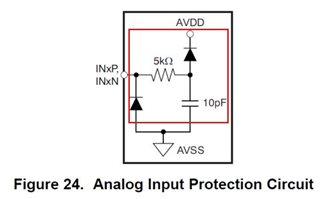Hello. I have a question about ads1294ic.
1. I'd like to know the purpose of RLDREF (PIN 60) and VCAP1,2,3,4.
For RLD, I understood that additional ECG signal input and OUTPUT FEEDBACK are used for CMRR removal, but I wonder how RLDREF is used here.
2. AVDD1 (PIN 54) and AVSS1 (PIN 53) have different naming, so I'd like to ask if there's any difference between AVDD and AVSS.
3. You are trying to configure PROTECTION CIRCUIT of ECG INPUT PIN, but the circuit configuration of DATASHEET and EVM is different.
Please check which circuit should be configured. (If you need to follow DATASHEET, please recommend the type of diode or product as well.))
4. I understand that IC thinks it's one person's ECG information even if more than one channel comes in, but I'd like to ask if it's possible to judge CH1 and CH2 as someone else.


Thank you.


